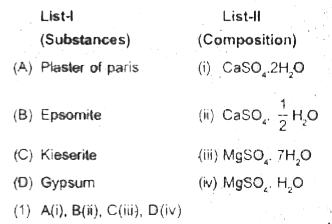Select the amphoteric substance in the following:
SO3
NaOH
CO2
Al(OH)3
The correct Answer is:D
To determine the amphoteric substance from the given options, we can follow these steps:
1. Understand the Definition of Amphoteric Substances:
- Amphoteric substances are those that can act as both acids and bases. They can react with acids to form salts and water, and they can also react with bases.
2. Identify the Given Options:
- The options provided include various compounds. For the purpose of this solution, let’s assume the options are:
1. SO3 (Sulfur Trioxide)
2. NaOH (Sodium Hydroxide)
3. CO2 (Carbon Dioxide)
4. Al(OH)3 (Aluminum Hydroxide)
3. Analyze Each Option:
- SO3 (Sulfur Trioxide): This is a non-metal oxide and is known to be acidic. It does not exhibit basic properties.
- NaOH (Sodium Hydroxide): This is a strong base (alkali) and does not exhibit acidic properties.
- CO2 (Carbon Dioxide): This is also a non-metal oxide and is acidic in nature. It does not exhibit basic properties.
- Al(OH)3 (Aluminum Hydroxide): This compound can react with both acids and bases. It can neutralize acids and also react with strong bases, making it amphoteric.
4. Conclusion:
- Among the given options, Al(OH)3 (Aluminum Hydroxide) is the only amphoteric substance because it can behave as both an acid and a base.
Final Answer:
The amphoteric substance among the given options is Al(OH)3 (Aluminum Hydroxide).
---
- Amphoteric substances are those that can act as both acids and bases. They can react with acids to form salts and water, and they can also react with bases.
- The options provided include various compounds. For the purpose of this solution, let’s assume the options are:
1. SO3 (Sulfur Trioxide)
2. NaOH (Sodium Hydroxide)
3. CO2 (Carbon Dioxide)
4. Al(OH)3 (Aluminum Hydroxide)
- SO3 (Sulfur Trioxide): This is a non-metal oxide and is known to be acidic. It does not exhibit basic properties.
- NaOH (Sodium Hydroxide): This is a strong base (alkali) and does not exhibit acidic properties.
- CO2 (Carbon Dioxide): This is also a non-metal oxide and is acidic in nature. It does not exhibit basic properties.
- Al(OH)3 (Aluminum Hydroxide): This compound can react with both acids and bases. It can neutralize acids and also react with strong bases, making it amphoteric.
- Among the given options, Al(OH)3 (Aluminum Hydroxide) is the only amphoteric substance because it can behave as both an acid and a base.
The amphoteric substance among the given options is Al(OH)3 (Aluminum Hydroxide).
Topper's Solved these Questions
- PERIODIC PROPERTIESBOOK - VK JAISWAL ENGLISHCHAPTER - PERIODIC PROPERTIESEXERCISE - Level 3 (Passage Type)
89 Videos
- PERIODIC PROPERTIESBOOK - VK JAISWAL ENGLISHCHAPTER - PERIODIC PROPERTIESEXERCISE - ONE OR MORE ANSWERS IN/ARE CORRECT
98 Videos
- p-BLOCK ELEMENTSBOOK - VK JAISWAL ENGLISHCHAPTER - p-BLOCK ELEMENTSEXERCISE - SUBJECTIVE PROBLEMS
35 Videos
- QUALITATIVE INORGANIC ANALYSISBOOK - VK JAISWAL ENGLISHCHAPTER - QUALITATIVE INORGANIC ANALYSISEXERCISE - SUBJECTIVE PROBLEMS
4 Videos
Similar Questions
Knowledge Check
Select correct answers from the choices A, B, C, D which are given. Write down only the letter corresponding to the correct answer.
Which of the following oxides is amphoteric?AZnOBCuOCFeODCaO
Which is not amphoteric?
View SolutionIn Bronsted an Lowry concept , water is regarded as an amphoteric substance . Give examples to justify this statement.
View SolutionMatch list-l with list-ii for the composition of substances and select the correct answer using the code given below the lists

View SolutionMatch list-l with list-ii for the composition of substances and select the correct answer using the code given below the lists

View SolutionGive two examples for each of the following:
(a) Substance which sublime
(b) Substances which do not change their state.
( c) Substances which are rigid and not compressible.
View SolutionExample of an amphoteric oxide is
View SolutionMatch the columns of bioactive substances and their roles and select the correct option.

Choose the correct match.
View Solution
